Well, deer’s diet is not like others, as it has a complex and unique dietary system which also may be called diverse dietary habits. But, do you have any idea about this majestic creature’s cuisine?
Okay, firstly the question that came to our mind is what do deers eat? Naturally, deer are herbivorous. They mostly favor acorns, apples, new shoots, juicy foliage and tender leaves, etc. However, seasonal variation, regional differences, and many more factors influence their eating habits.
In this article, I will discuss different influencing factors of deer diet. Then, I will talk about captive and fawn deer feeding habits along with various deer examples.
Now, let’s delve into the majestic world of deer to unlock the secrets and what they really eat in their lifetime.
What Are the Eating Habits of Deer?
Deer are especially herbivorous creatures which means they exclusively munch on different plants. But do they solely rely on plants? No, their menu is not limited and they not only eat salad but also eat a buffet where various grasses, leaves, nuts, fruits, mushrooms and so on are included.
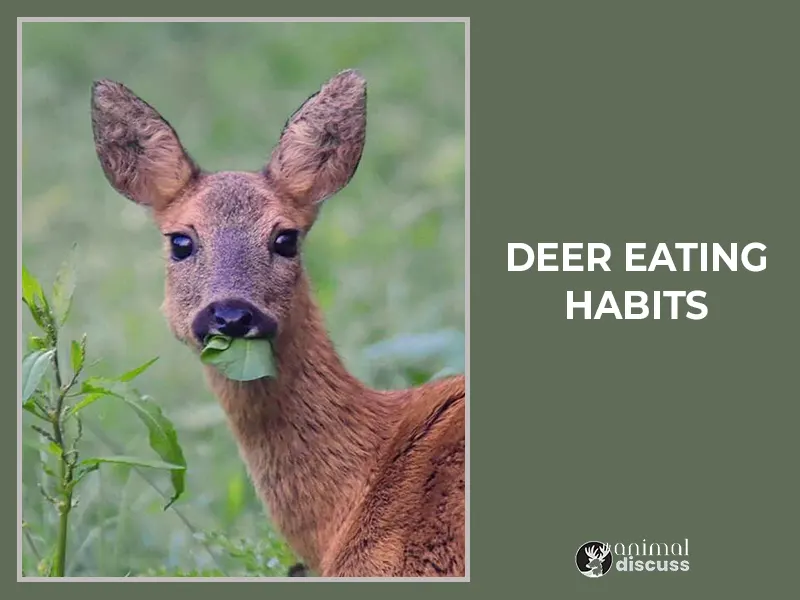
Now, start talking from here to gain a better knowledge of deer diet and the relationship between deer and their environment. [Reference Source]
Factors Influencing Deer’s Eating Habits
As I mentioned earlier, there are various factors that influence the eating habits of deer. Let’s have a look at them in detail.
Regional Influences
Different types of plants, seeds and other food items available in different regions make diversity in the deer diet. For instance, deer live in forests, meadows, and different urban landscapes; these are influencing factors that shape their dietary habits.
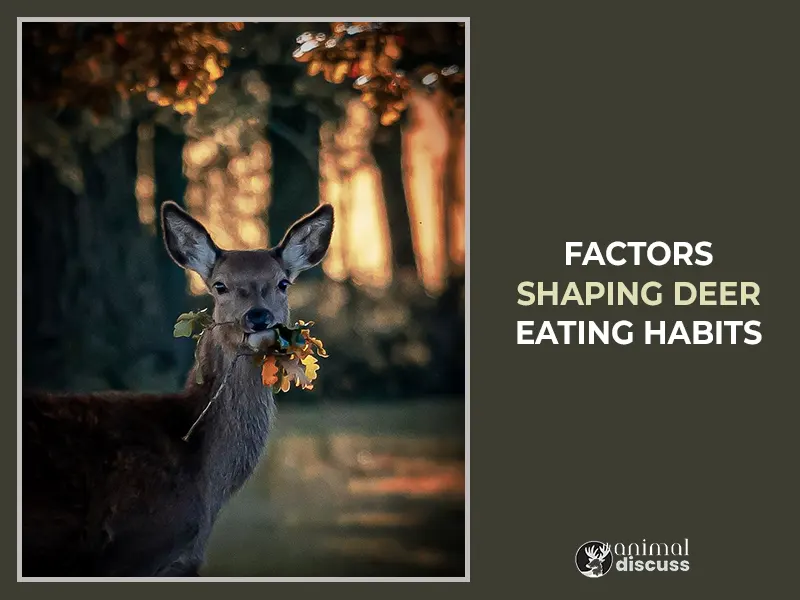
Accordingly, deer in various parts of the country meet different plants, which causes differences in their dietary patterns. These geographical impacts modify their favorite food sources, allowing them to adapt to the resources found in their respective environments.
Now, which types of food do deer consume from different parts of the world? Lichens and fir needles are consumed by deer in northern wood, but grassland deer consume succulent grasses and wildflowers.
Likewise, Southern deer eat salty vegetation and seaweed. For instance, North American white-tailed deer eat plants with leaves and agricultural crops when they become available.
Variation of Seasons
Every season has a variety of fruits as well as foods. These various items provoke deer to change their food habits to survive.
Seasonal variations have a substantial impact on deer feeding habits. Deer adjust their feeding patterns to the resources that are accessible as the climate changes throughout the year.
Let’s look at how different seasons affect deer eating habits.
01. Summer
What do deer actually eat in summer? Well, deer have a taste palate like humans and they like to eat juicy fruits in summer as well as vegetables. Moreover, I found an astonishing fact that deer can eat 20 different plants in a day. Also, deer can consume three-to-ten-pound food in one day.
Now, one question can come in about which specific food deer exactly consume in summer. Their consuming foods in summer are:
- Sweet fruits include blueberries, plums, blackberries, grapes, luscious bogwood flowers, oat leaves, etc.
- All types of nuts; especially walnuts and acorns.
- Young green grass, corn, mushroom, soybeans, rye, alfalfa.
- Wild lettuce is the most favorite among deer in leafy vegetables.
02. Fall
Autumn or fall is a bountiful season for deer since trees provide fruit and seeds. Deer enjoy the benefits of the seasonal reward, gorging on fruits and seeds to get ready for the colder months ahead. During this time of year, several deer species prefer acorns.
Why do deer prefer acorns during winter? Because it provides them vital carbohydrates to retain as fat stores along with different mast crops. This season gives deer rewards as high-carbohydrate food and changes in their eating habits.
What do you think about deer’s preferred diet in the fall? Okay, then let’s see their most preferable food to consume.
- White oak acorns are the most preferable food to deer. Because they pick this among all other kinds of food as it has less tannins.
- They try to finish all leftover food before moving into acorns.
- Deer also prefers to eat pods from honey locust trees
03. Winter
Deer digestive tracts are generally geared up throughout the winter to process their usual diet of woody browse, twig tips, and buds. A meal obtained by browse cutting gives sustenance with little delay in obtaining energy from the meal.
In the winter season, deer mostly stick with woody browse because of excessive snowfall and arrange their food. Also, in the North, deer get nutrition from twigs and herbaceous as well as maple, ash, birch, or witch hobble.
However, surviving in the winter season is not that easy. For that reason, deer need to get food to survive. Some consuming foods in the winter are:
- Standing Corn is one of the winter foods for deer which makes them strong and they should not eat it until it turns cold. There are many years when rainy weather prohibits farmers from harvesting some cornfields, which remain standing and benefit winter wildlife.
- Brassicas are another winter food for deer with long leaves and deer can easily dig the roots in snow.
- Acorns are easy to dig until excessive snowfall starts and it is one of the favorite foods of deer.
- Young Woody Browse may not appear like a smorgasbord to you, but it does to a deer and it helps them to be energetic.
04. Spring
Deer devote their attention to young branches and fragile green sprouts as winter fades and the environment awakens.
After a long winter, spring offers a rebirth of grasses and forbs, which provide a renewing food supply for deer. The Springtime treats aid deer in regaining health and preparing for the breeding cycle.
Soybean is one of the most favorite foods of deer during spring. Wildflowers and a few dandelions are found by deer in the early spring as well as vines and weeds.
Necessary Nutrients While Deer Consuming Food
Captive deer, growing fawns, lactating mother, and stag are required to have different kinds of food according to their need and circumstances. Their foods vary from one another because of their physical growth and activities.
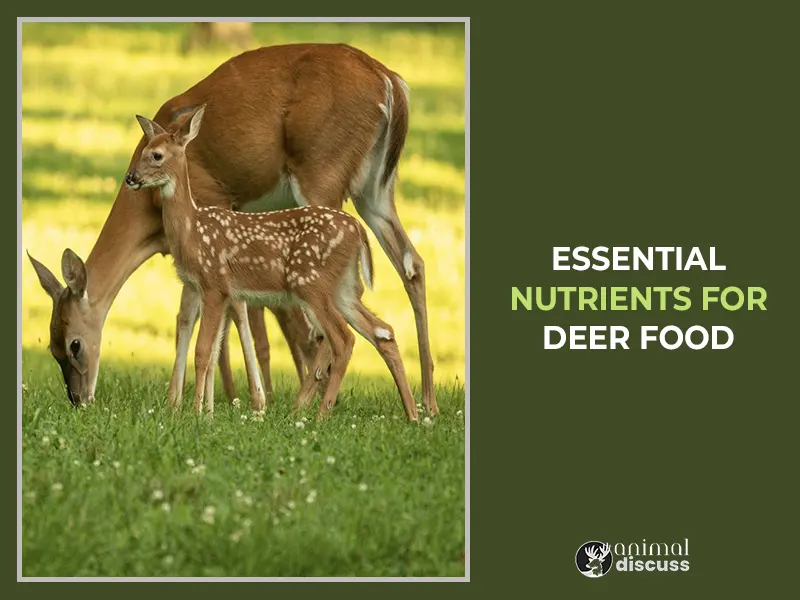
Consequently, deer need a precise dietary balance, which includes protein, carbs, lipids, minerals, energy, water and vitamins.
How important is this nutrition? Well, this nutrition offers sufficient power for deer’s busy lifestyle, as well as promotes growth and reproduction and overall wellness.
Does each type of nutrition have the same kind of benefits? No, a variety of nutrition carries diverse kind of benefits and now I am going to talk about them:
- Protein helps to grow muscle and repair, lactation and reproduction
- For getting energy, carbohydrates help a lot
- During feeding, fiber helps deer to digest their food
- Fats are important for insulation and energy storage
- Physiological functions operate through various minerals and vitamins
- Water is a critical component for deer bodies and it helps them when they eat different vegetables. Also, 70%-75% of body weight is composed of water
Eating Habits of Various Deer
Deer’s different species belong to different countries and places. Every place and country does not have similar weather to grow the same plants.
Moreover, all deer digesting capabilities are also different which is also the reason for unique dietary niches.
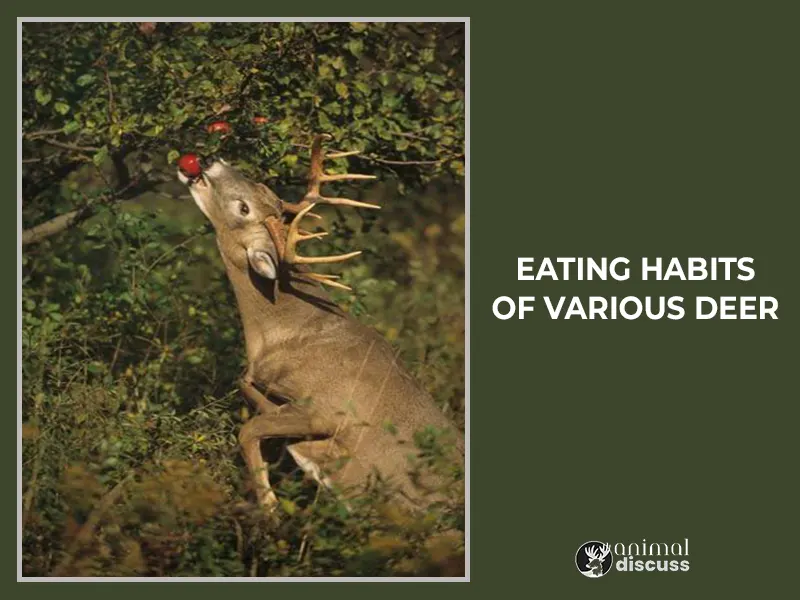
Let’s get started and look at some of the most popular deer species’ dietary habits.
Roe Deer
These little deer eat grass as well as leaves, berries, and mushrooms. Moreover, Roe deer eat a variety of plants, especially grasses, herbs, and woody browse.
In summer, they mostly eat on grasses and forbs, transitioning to woody plants in the winter. Also, Beech nuts, one of their favorite snacks, are abundant on the Chevin.
Red Deer
These bigger deer prefer grasses, herbs, and browse, as well as timber in the winter. In addition, red deer eat a variety of plants, including grasses, heather, sedges, and browsing.
They change their diets according to the seasons, feeding on meadows in the summer and woody vegetation, bushes, and wood in the winter.
Fallow Deer
Fallow deer eat a variety of grasses, fruits, leaves, and agricultural products. They also eat different plants, forbs, brambles, and tree shoots. Their wandering tendencies are most noticeable during the winter when other food sources are sparse.
Muntjac
These little deer eat on leaves, fruits, and twigs. Muntjac, often known as howling deer, eats a wide range of flora, including shrubs and bushes, and decaying leaves.
While readily accessible, they are known to ingest fruits and berries, supplementing their diet with these seasonal delights.
Sika
They consume grasses, plants, and browse, as well as acorns and berries, similar to red deer. Sika deer are flexible feeders who enjoy eating a variety of plants. Grass, herbs, aquatic plants, and browsing make up what they eat.
To supplement their food supply throughout the winter, they graze on woody vegetation and tree bark.
Chinese Water Deer
Aquatic vegetation, foliage, and fruits are consumed by these semi-aquatic Chinese water deer.
As the name implies, Chinese Water Deer have evolved to a semi-aquatic existence and largely eat aquatic plants such as reeds, sedges, and water lilies. They also feed on bushes and woody plants present in riparian areas.
Reindeer
Reindeer food consists primarily of Arctic-adapted lichens, grasses, and shrubs. They eat lichens, grasses, sedges, and woody plants, among other things.
Their capacity to eat lichens even during the severe winter months distinguishes them from different deer kinds.
What Do Captive Deer Eat?
Due to differences in accessible food sources, captive deer’s eating patterns might vary considerably from those of wild deer. Captive deer are frequently fed a well-balanced diet that mimics their normal eating patterns, guaranteeing their general health and well-being.
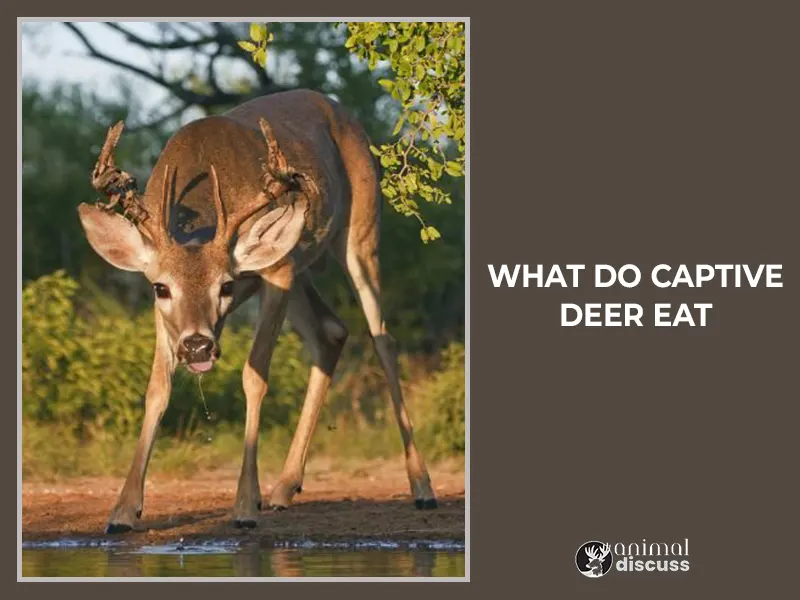
They usually eat a mix of hay, pellets, and fresh veggies, which ensures they obtain all the minerals and vitamins they need. They also get the nutrition they need while avoiding browsing on landscaping plants.
Food Consuming Habit of Fawn Deer
Fawn or baby deer has different food needs than adult deer. As they still rely largely on their mothers’ milk for development and nutrition, fawns start nibbling on greenery at an early age.
This activity helps them prepare for the ultimate switch to a completely plant-based diet.
They progressively begin to emulate their mother’s feeding patterns after weaning, learning to browse and graze on various plants.
Which Meal Deer Prefer to Eat?
While deer have a wide range of tastes, particular foods are consistently popular among every species. Deer have been known to be excited and delighted by acorns, apples, new shoots, and tender leaves, demonstrating their enthusiasm for these delightful delights.
As deer eat a variety of meals, they frequently favor high-energy, readily digested foods. Though tastes differ throughout species and individuals, all deer appear to have a penchant for juicy foliage, sweet berries, and crisp acorns. These meals’ vitamins, minerals and energy density explain their popularity.
The Strategy of Hunting Food for Feeding
When it comes to looking for food, deer use a calculated strategy. To identify the availability of prospective food sources, they use their sharp senses, such as their strong sense of smell and superb hearing. Their senses are similar to humans as they also have five senses.
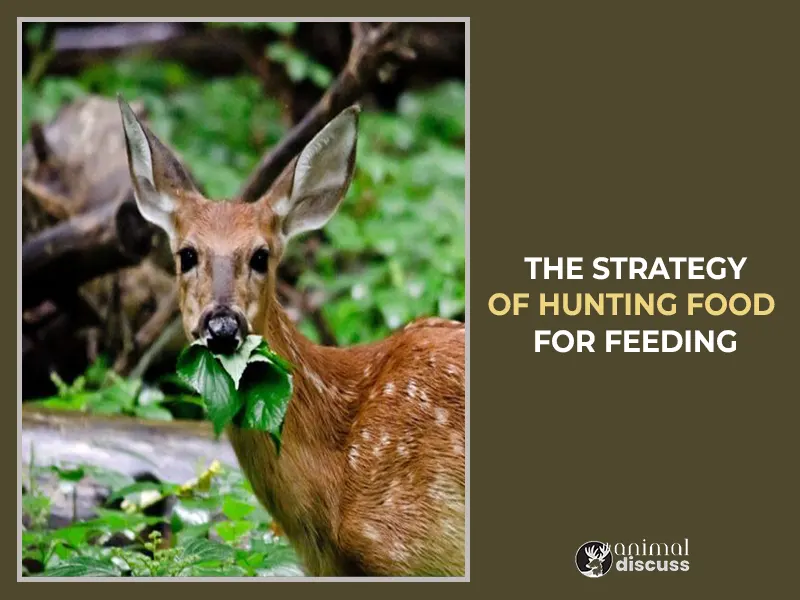
Deer glide gracefully around their surroundings, carefully browsing and grazing to fulfill their appetite, thanks to their developed abilities to navigate their surroundings.
Food Digestion Mechanism of Deer
Deer have sophisticated systems of digestion allowing them to handle their diet of vegetables efficiently.
A four-chambered stomach allows for comprehensive decomposition of plant material, guaranteeing efficient nutrient absorption. This distinct digesting mechanism distinguishes deer from animals that are carnivorous.
Rumen, Reticulum, Omasum and Abomasum are four chambers that help to digest food. Deer used to eat high protein and vitamins food.
- Here, Rumen helps to break down simple sugar and fatty acids.
- Then, the Reticulum sends food to the Rumen for re-chewing big pieces of food.
- Omasum is used to absorb water for digestion properly and Abomasum, which is considered as a true stomach and secret enzyme for proper digestion.
Do Deer Browse or Graze?
One common question: what always makes people confused about deer browsing or grazing? Well, deer are both grazers and browsers.
Deer have two unique eating behaviors: browsing and grazing. Browsing is the intake of woody plant components like leaves and twigs, whereas grazing is the eating of grasses and forbs. Deer adeptly switches between these activities in response to the availability of food and seasonal changes.
Frequently Asked Questions
Now, Let’s check out some commonly asked questions regarding Deer’s eating habits.
01. Can Deer Survive on Human Food Alone?
No, deer can not survive with good health on human food as well as human interaction because deer are herbivorous creatures and not meat eaters like humans. Also, their digestion system is unique.
02. Do the Eating Habits of Deer Vary in Different Regions?
Yes, the eating habits of deer are different according to different regions. Deer mostly eat leaves and grasses which shape their eating habits in different places. Thus, they ensure to get food everywhere and it influences them to change their diet.
Conclusion
The feeding habits of deer reveal a lot about their lifestyles and adaptations. To live and thrive in their individual habitats, these amazing species rely on a perfectly balanced and diversified diet.
Deer use their innate instincts and specific eating patterns to survive, moving from the lush greenery of summer to the bleak landscapes of winter.
We may better appreciate the beauty of these great animals and contribute to their protection by studying and respecting the subtle nuances of their nutritional preferences.
So, the next time you see a deer grazing or browsing in the woods, take a minute to marvel at the breadth of their diet and the beauty of the natural environment they inhabit.
References:
- https://www.msudeer.msstate.edu/deer-diet.php
- https://academic.oup.com/aobpla/article/10/1/plx047/4107548
- https://dec.ny.gov/nature/animals-fish-plants/white-tailed-deer/winter-deer-foods/cutting-browse
- https://animalrangeextension.montana.edu/wildlife/private_land_wildlife_mgmt/winter-deer-feeding.html
- https://now.tufts.edu/2018/01/30/how-do-deer-survive-harsh-winter-weather
- https://ipm.missouri.edu/meg/2020/3/deerResistantPlants/
- https://extension.missouri.edu/publications/g9487

